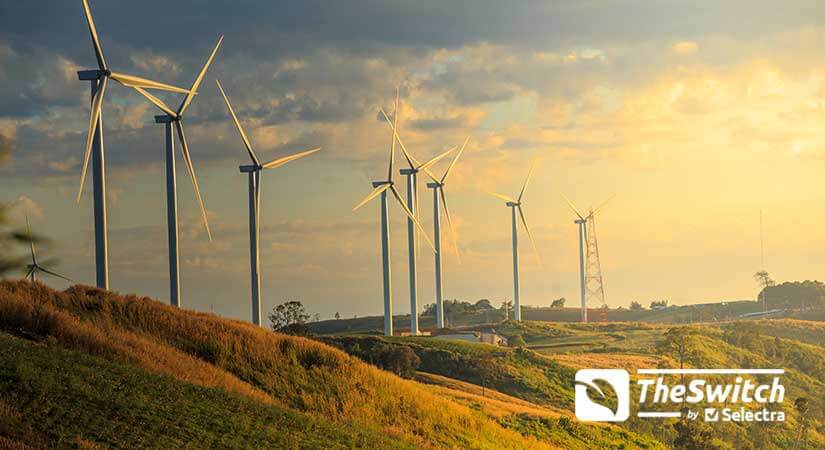Wind Energy in the UK: Learn the basics

Whilst the wet and windy weather is a daily grievance for us Brits, our incessantly dodgy climate does have one benefit. As the windiest country in Europe, we are perfectly placed to generate renewable electricity from wind energy, and we are slowly beginning to take advantage of this entirely clean and endless source of energy. In the following guide, we're going to take you through everything you need to know about wind energy.
Wind energy generation has grown fairly rapidly in the past decade and the UK is now the sixth-largest wind energy producer in the world after China, the USA, Germany, India and Spain. In 2017, 15% of the UK’s entire electricity was generated from wind energy, enough to power 12.7 million homes across the country.
This makes wind our primary source of renewable energy in the UK. In fact, we now generate twice as much from wind energy as from coal. This is great news for the future of the country and our planet, but we can do more - as the windiest country in Europe, surely we should be topping the list of European wind energy producers?
How does wind energy work?
You might be surprised to learn that wind energy actually begins with the sun and is essentially a form of solar energy. The sun heats the surface of the earth unevenly because of the earth’s irregular surfaces of mountains, hills, oceans and other terrain. This uneven heating of the earth creates areas of warm air that rises up and cold air that sinks and moves into its place.
The movement of air and changes in air pressure cause winds to form. The wind’s natural energy can then be turned into electricity using ‘wind turbines’ that are grouped together in ‘wind farms’, both inland and off the coast of the UK. Let's learn a bit more about this technology:
Wind turbines
To turn the wind energy into electricity requires the use of turbines placed in windy areas of open land or in shallow water around the coast of the UK. Wind turbines are huge structures, typically around 150 metres tall, topped with two or three rotating blades. The force of the wind causes the blades to spin, powering a generator that in turn converts this kinetic energy (in other words, movement) into electricity. Wind turbine blades typically span 20 to 80 metres and can turn 13 to 20 times a minute depending on the strength of the wind, the size and type of turbine.

At the time of writing, there are currently around 8,600 onshore wind turbines in operation across the UK, plus about 2,300 more offshore. This amounts to a total maximum capacity of over 24,100 megawatts of electricity and equated to 20% of Britain's total electricity generation in 2019 and 54% of our renewable electricity.
In the UK, our tallest wind turbines are located off the coast of Liverpool at the Burbo Bank Offshore Wind Farm. Standing at 195 metres, they are taller than the Blackpool Tower and the Gherkin. With 80 metre long blades, each turbine has a capacity of 8 megawatts which is enough to power a home for 29 hours with just a single rotation.
As the wind is variable throughout the day, so is the amount of times the blades turn meaning the amount of power generated increases and decreases constantly. Because of this, wind turbines are often grouped together in ‘wind farms’ in order to both maximise output and generate a steady supply of energy throughout the day.
Wind Farms
Wind turbines are often grouped together in wind farms in order to multiply the amount of energy that can be generated in any one location. Wind farms are either located ‘onshore’ in areas of open land, or ‘offshore’ positioned off the coast in areas of shallow water and high levels of wind.
Energy produced from onshore wind farms is currently the leading producer of the two, contributing 8.5% of the UK’s total electricity output. In addition, offshore wind farms contribute 6.2% of the UK’s electricity. Together they are able to power 12.7 million UK homes and this is expected to increase as investment continues in new wind farms around Britain.
Britain’s Onshore Wind Farms
At the current time, the majority of wind energy generation in the UK comes from wind farms based inland or ‘onshore’. Traditionally, wind farms were installed onshore because they were cheaper to build and maintain. They have to endure less wear and tear compared to turbines located in offshore wind farms. The downside however, is that wind is less reliable and more irregular onshore, meaning they typically generate less energy compared to those located off the coast.

Whitelee Wind Farm in Eaglesham, Glasgow is currently the largest onshore wind farm currently operating in Scotland, and the UK overall. Whitelee Wind Farm has 215 wind turbines which can generate 539 megawatts of electricity when running at peak capacity. This output is enough to power around 300,000 homes in Scotland at any one time.
In Wales, the Pen y Cymoedd Wind Farm opened in 2017 with 76 turbines and a capacity of 228 megawatts - enough to power 188,000 Welsh homes and save 300,000 tonnes of CO2 emissions.
In England, Little Cheyne Court in Kent, has 26 wind turbines with a peak output of 59.8 megawatts. Little Cheyne Court generates enough electricity to power 33,000 homes in England per year.
Northern Ireland’s main onshore wind farm is Slieve Rushen Wind Farm. Slieve Rushen has a modest 18 turbines and total capacity of 54 megawatts that can power 30,000 homes in Northern Ireland.
Britain’s Offshore Wind Farms
Since 2008, the UK has been the leading offshore wind power-generating country in the world. Whilst offshore wind farms are more expensive to install, they are able to generate more power than onshore farms due to the increased wind intensity and consistency at sea. Offshore farms also remove issues that often cause problems onshore such as noise pollution and visual interference for local residents.
The London Array is Britain’s, and the world’s, largest offshore wind farm with 175 wind turbines spread over 38 square miles (100km). Located 20 km off the coast of Kent, it generates 630 megawatts of electricity, enough to power almost 500,000 households across London and the South East whilst also reducing CO2 emissions by 925,000 tonnes per year.
Off the coast of Scotland is Robin Rigg Wind Farm in Solway Firth which has 58 wind turbines and a capacity of 180 megawatts. It currently powers 120,000 Scottish homes and offsets 235,000 tonnes of CO2 every year that would be released into the atmosphere if it weren’t for wind energy.
In Wales, there is the Gwynt y Môr Wind Farm with 160 turbines that can generate 576 megawatts of electricity. Located in the Irish Sea off the north coast of Wales, Gwynt y Môr Wind Farm has the ability to power 400,000 households in Wales and cuts CO2 emissions by 1.7 million tonnes per year.
| % of UK’s total electricity | Number of homes powered per year | Planned investment for next four years |
|---|---|---|
| 15% | 16 million | £17.5 billion |
| Number of UK wind turbines | Number of UK windfarms | Tonnes of CO2 saved annually |
| 10,420 units | 2,450 sites | 26 million |
What are 5 advantages of wind energy?
Wind energy is a wonderful source of renewable energy and has numerous benefits. Wind energy will never run out, it’s clean, cheap to produce and we have more than enough wind to meet the entire UK’s electricity needs many times over - once the infrastructure is in place. The main advantages of wind energy are as follows.
1. Eco-friendly and sustainable
Wind energy is an entirely ‘clean’ source of energy and doesn’t cause any pollution or greenhouse gasses. It also contributes massively to reducing CO2 emissions compared to fossil-fuel energies - helping the world to reverse climate change in a small, but important way.
Unlike fossil fuels, wind will never run out as it is continually being produced by the sun. For as long as the sun is shining, wind will be produced and can be harnessed for energy. As Europe’s windiest country, we have an abundance of wind that can generate large amounts of sustainable energy and the more we use it, the more it will reduce CO2 emissions and have a positive impact on the future of our planet.
2. Cheap to generate

Wind energy is one of the most cost-effective sources of renewable energy around.
Whilst installing the infrastructure is fairly costly, once it’s up and running, it’s a low cost source of energy to generate. The only real costs post-installation is maintenance of the wind turbines.
According to Bulb Energy, wind energy in 2017 cost the same to generate as conventional gas and is far cheaper than nuclear energy. Offshore wind energy in particular has reduced in price by nearly 50% since 2015 and by 2020 wind energy will be cheaper than any other type of power generation.
All of this means more and more consumers have access to and can afford green energy and are still able to benefit from reduced bills compared to fossil fuels.
Once the renewable infrastructure is built, the fuel is free forever. Unlike carbon-based fuels, the wind and the sun and the earth itself provide fuel that is free, in amounts that are effectively limitless. - Al Gore
3. Creation of wind energy jobs
Wind energy has economic benefits too, creating thousands of wind energy jobs with the companies manufacturing the turbines. With all the investment in wind energy in recent years, the number of wind energy jobs have been growing to manage, construct and maintain wind farms and wind energy infrastructure. Jobs and internships in roles such as wind turbine technicians, engineers, designers, analysts and project managers are just some of the roles that are in increasing demand thanks to wind energy.
In the UK, 42,000 people were employed in the wind energy sector between 2015 - 2016. This represented one third of the total 126,000 jobs across all renewable energy sectors during the same period and makes wind energy the clear leader in renewable energy employment in the UK. Employment in the renewable industry is predicted to create around 40,000 jobs by 2020. If wind energy jobs continue to contribute one third of those 40,000 positions, this will likely mean the creation of around 13,000 new wind energy jobs by 2020. This would take total wind energy employment in the UK to around 55,000.
Worldwide, wind energy is also a huge employer with 1.1 million people employed in the wind energy sector out of a total 9.8 million employed across all renewable energies. However, jobs in solar energy represent the main source of employment globally, with 3.1 million jobs.
4. Reduces reliance on imported energy
All of this homegrown energy production also reduces our reliance on energy imports from abroad. This has the benefit of increased security during times of reduced supply of energy sourced from abroad. It also gives the UK better control over energy prices compared to the fluctuating prices of foreign energy that we cannot control.
5. Efficient use of space
Wind farms may need plenty of space in between each turbine to prevent turbulence, but the land in between can often been utilised for agricultural purposes. This means landowners and agricultural farmers can install their own wind turbines with minimal disturbance to the land, or rent the land to wind farm companies.
Whilst onshore wind farms may cause aesthetic interference to local residents, the actual amount of land required is fairly minimal. Likewise, offshore wind farms take up relatively small amounts of space and do not interfere with shipping lanes or important waterways. They are only restricted by the varying depths of the water around Britain’s coast.
What are 3 disadvantages of wind energy?
Whilst we are big advocates of wind energy and renewable energy sources in general, wind-powered electricity is still a fairly new innovation and has its flaws. The disadvantages of wind energy include:

1. Inconsistent and unreliable
Wind energy is of course governed by mother nature and is therefore somewhat inconsistent and unreliable. Onshore wind farms are particularly inconsistent due to irregular wind patterns on land. In the UK we are lucky to receive a high amount of wind overall, but in other countries wind is far more scarce and therefore less viable as a form of renewable energy.
Although we can maximise wind energy generation in the UK by installing wind farms offshore where wind is more consistent, the infrastructure involved is more expensive to install and maintain due to the logistics of accessing and working with the offshore sites. And whilst we can generate a decent amount of wind energy in the UK, the variable output means it is difficult to rely on wind to power our electricity 100% of the time.
2. High initial investment
To plan and implement a new wind farm remains an expensive investment and as such many projects in the past have relied on government funding and subsidies. Installing offshore wind farms is particularly costly due to the logistical issues of installing wind turbines in water. The London Array Wind Farm for example cost £1.8 billion to plan and construct. That’s a lot of energy generation needed to recoup the costs.
3. Interference to local residents
Depending on where you live in the UK, one drawback to some is the visual interference of wind turbines. Wind farms located onshore are often in areas of beautiful countryside which for some local residents obstruct their views. Homeowners living close to wind farms also complain of the noise they generate. Whilst these issues may only affect a small percentage of the British public, they cannot be dismissed and have caused anger in the past for sections of the British population.
Scotland Are Leading the Way in Wind Energy
Within the UK, it’s the innovative Scots who have embraced wind energy the most. In 2017, wind farms including Whitelee Wind Farm and many others generated enough electricity to power 3 million homes in Scotland within just six months. That’s a huge 6.6 million megawatt hours of electricity sent to the National Grid.
The world’s most powerful turbine has also recently been installed off the coast of Aberdeen. The first of 11, it will form part of Scotland’s largest offshore wind farm - the Aberdeen Bay Wind Farm. The developers claim that it will power 70% of Aberdeen’s homes and that a single rotation of its huge 80 metre length propellers can power a home for an entire day. Though US President Donald Trump objected to the plans - claiming it would be an eyesore for his nearby golf club - it was successfully installed and will begin powering Aberdeen’s homes soon.
The Scottish government also recently claimed that 25% of Europe’s entire offshore wind resources are based in Scotland and they have created over 58,000 jobs in the renewable energy sector. In addition, the government achieved its aim for 100% of its electricity supply to come from renewable sources on several days in 2020.
Scotland is also paving the way with renewable energy on the whole, with investments in tidal energy also helping boost their green credentials. Not only are they tackling climate change and generating vast amounts of renewable energy, they are also creating jobs and bringing in major investment to the industry. Whilst England, Wales and Northern Ireland are doing their part, they’ll need to increase their investment and commitment to the green energy sector to catch up with Scotland.
The Future of Wind Energy in the UK
In recent years, generation and usage of wind-powered energy has grown quickly and does not seem set to slow down anytime soon. New investment into wind energy is continuing, with the ambitious ‘Hornsea Project One’ project set to be the world’s largest offshore wind farm - penned for completion in 2020. Located 75 miles off the Yorkshire coast, Hornsea Project One will be able to supply wind-powered energy to over 1 million homes.
Once completed, work will follow on ‘Hornsea Project Two’ which will expand on the first project - powering up to 1.6 million homes in the UK. ‘Hornsea Project Three’ is set to follow thereafter.
These are just some of the UK’s planned wind energy infrastructure improvements, but shows Britain is serious about upping its wind energy generation in the coming years. Not only is this a great sign for the environment and increasing access to green energy to consumers, this investment will also create new jobs in the renewable sector.
The offshore wind sector alone will invest £17.5bn in the UK up to 2021 and thousands of new jobs in British businesses will be created. - Richard Harrington - former UK Minister for Energy and Industry
Which UK suppliers provide energy from wind?
Wind energy is a growing source of renewable energy and there are plenty of suppliers in the UK offering competitively priced electricity generated by the wind.

